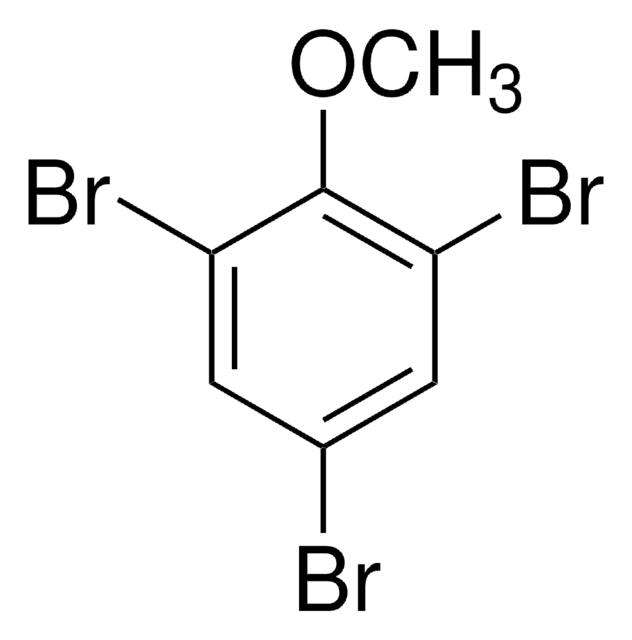추천 제품
vapor density
11.4 (vs air)
분석
99%
bp
282-290 °C/746 mmHg (lit.)
mp
90-94 °C (lit.)
solubility
water: soluble 0.007g/100ml at 25 °C
chloroform: soluble
diethyl ether: soluble
ethanol: soluble
methanol: soluble
methylene chloride: soluble
SMILES string
Oc1c(Br)cc(Br)cc1Br
InChI
1S/C6H3Br3O/c7-3-1-4(8)6(10)5(9)2-3/h1-2,10H
InChI key
BSWWXRFVMJHFBN-UHFFFAOYSA-N
유사한 제품을 찾으십니까? 방문 제품 비교 안내
일반 설명
2,4,6-Tribromophenol undergoes oxidative degradation catalyzed by SiO2-supported iron(III)-5,10,15,20-tetrakis(4-carboxyphenyl) porphyrin. It is degraded by Bacillus sp.GZT strain via reductive bromination as major degradation pathway. It is a widely used brominated flame retardant.
애플리케이션
2,4,6-Tribromophenol was used in analysis of nonylphenol, nonylphenol monoethoxylate and octylphenol in sediment, water and fish tissue.
신호어
Warning
유해 및 위험 성명서
Hazard Classifications
Aquatic Acute 1 - Eye Irrit. 2 - Skin Sens. 1
Storage Class Code
11 - Combustible Solids
WGK
WGK 3
Flash Point (°F)
Not applicable
Flash Point (°C)
Not applicable
시험 성적서(COA)
제품의 로트/배치 번호를 입력하여 시험 성적서(COA)을 검색하십시오. 로트 및 배치 번호는 제품 라벨에 있는 ‘로트’ 또는 ‘배치’라는 용어 뒤에서 찾을 수 있습니다.
이미 열람한 고객
Estrogenic alkylphenols in fish tissues, sediments, and waters from the UK Tyne and Tees estuaries.
Lye CM, et al.
Environmental Science & Technology, 33(7), 1009-1014 (1999)
Qianqian Zhu et al.
Journal of environmental science and health. Part A, Toxic/hazardous substances & environmental engineering, 48(13), 1593-1601 (2013-08-21)
Iron(III)-porphyrin complexes are generally regarded as green catalysts, since they mimic the catalytic center of cytochrome-P450 and widely used as green catalysts for degrading halogenated phenols in wastewater, such as landfill leachates. However, iron(III)-porphyrins are deactivated by self-oxidation in the
Kristina Arnoldsson et al.
Environmental science & technology, 46(13), 7239-7244 (2012-06-13)
Polybrominated dibenzo-p-dioxins (PBDD) are emerging environmental pollutants with structural similarities to the highly characterized toxicants polychlorinated dibenzo-p-dioxins. The geographical and temporal variations of PBDD in biota samples from the Baltic Sea do not display features that are normally related to
C Pizarro et al.
Journal of chromatography. A, 1217(49), 7630-7637 (2010-11-03)
A dispersive liquid-liquid microextraction (DLLME) method has been optimised for simultaneously extracting 2,4,6-trichloranisole (TCA), 2,3,4,6-tetrachloroanisole (TeCA), 2,4,6-tribromoanisole (TBA), pentachloroanisole (PCA), 2,4,6-trichlorophenol (TCP), 2,3,4,6-tetrachlorophenol (TeCP), 2,4,6-tribromophenol (TBP) and pentachlorophenol (PCP) from wine. The haloanisoles and halophenols were automatically determined using a
Anna Norman Haldén et al.
Aquatic toxicology (Amsterdam, Netherlands), 100(1), 30-37 (2010-08-20)
The bromophenol 2,4,6-tribromophenol (TBP) is widely used as an industrial chemical, formed by degradation of tetrabromobisphenol-A, and it occurs naturally in marine organisms. Concentrations of TBP in fish have been related to intake via feed, but little is known about
자사의 과학자팀은 생명 과학, 재료 과학, 화학 합성, 크로마토그래피, 분석 및 기타 많은 영역을 포함한 모든 과학 분야에 경험이 있습니다..
고객지원팀으로 연락바랍니다.














